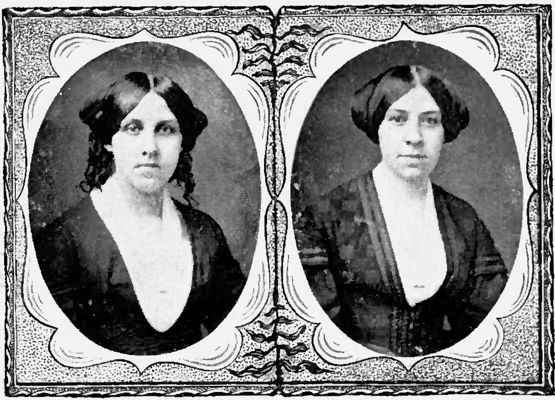
 JO AND MEG.
JO AND MEG.copies of early daguerreotypes.
"It was at this period of her life that she was violently attacked by amania for the stage, and writing and enacting dramas. Her older sister,Anna, had the same taste, and assisted her in carrying out all her plans."
Mrs. Cheney's Life of Louisa M. Alcott.
Comic Tragedies
WRITTEN BY "JO" AND "MEG"
and acted by
THE "LITTLE WOMEN"
BOSTON
ROBERTS BROTHERS
1893
Copyright, 1893,
By Anna B. Pratt.
University Press:
John Wilson and Son, Cambridge, U.S.A
CONTENTS.
- Page
- A Foreword, by Meg7
- Norna; or, The Witch's Curse17
- The Captive of Castile; or, The Moorish Maiden's Vow97
- The Greek Slave 149
- Ion 211
- Bianca: an Operatic Tragedy 261
- The Unloved Wife; or, Woman's Faith 279
A FOREWORD BY MEG.
In the good old times, when "Little Women"worked and played together, the big garretwas the scene of many dramatic revels. Aftera long day of teaching, sewing, and "helpingmother," the greatest delight of the girls wasto transform themselves into queens, knights,and cavaliers of high degree, and ascend into aworld of fancy and romance. Cinderella's godmotherwaved her wand, and the dismal roombecame a fairy-land. Flowers bloomed, forestsarose, music sounded, and lovers exchangedtheir vows by moonlight. Nothing was tooambitious to attempt; armor, gondolas, harps,towers, and palaces grew as if by magic, andwonderful scenes of valor and devotion wereenacted before admiring audiences.
Jo, of course, played the villains, ghosts,bandits, and disdainful queens; for her tragedy-lovingsoul delighted in the lurid parts, and nodrama was perfect in her eyes without a touchof the demonic or supernatural. Meg loved thesentimental rôles, the tender maiden with the[Pg 8]airy robes and flowing locks, who made impossiblesacrifices for ideal lovers, or the cavalier,singing soft serenades and performing lofty actsof gallantry and prowess. Amy was the fairysprite, while Beth enacted